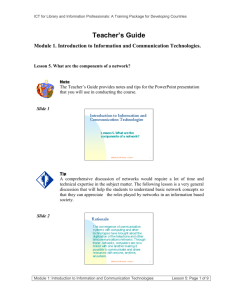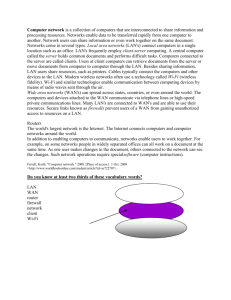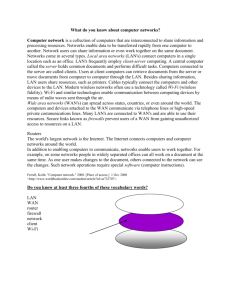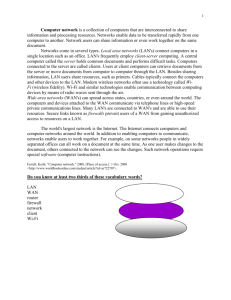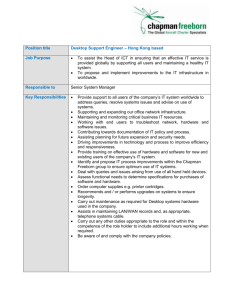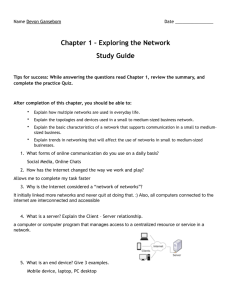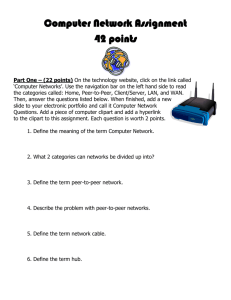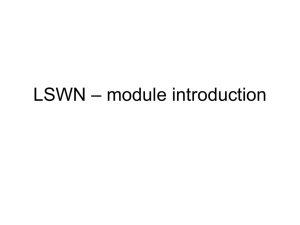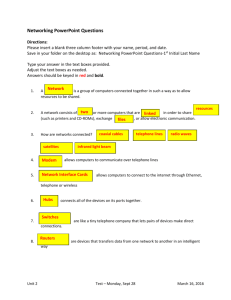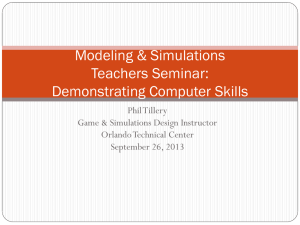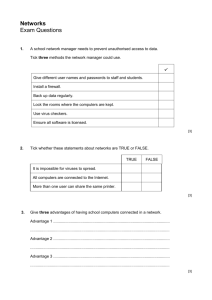Introduction to Information System
advertisement
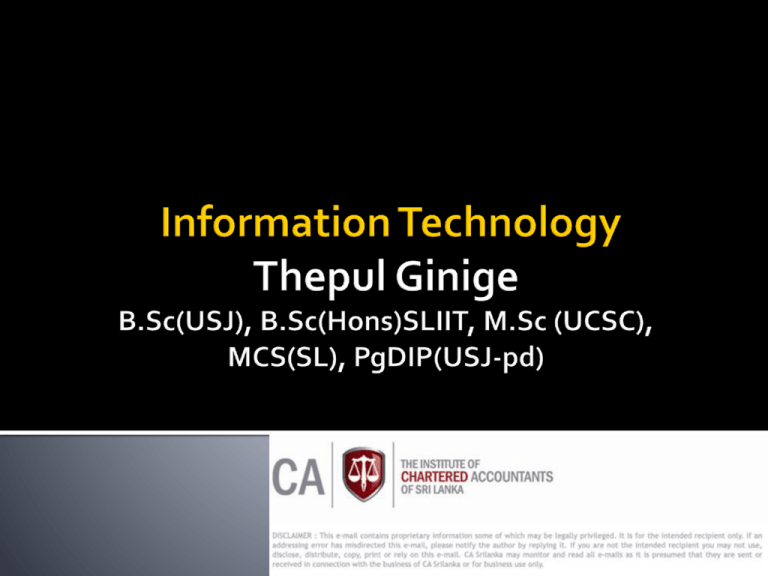
1 Introduction to Management Information Systems 2. Information systems and its alignment with Business Objectives 3. Centralized and Decentralized information systems and outsourcing IS 4. Accounting and Costing issues in delivering Information Systems 5. Structural issues in organizing information systems 6. Disaster recovery and other risk management issues 7. Selecting and implementing an Information System including project planning 8. Legal environment and legal issues surrounding information systems 1. 2 Assignments Written test 50% 50% 3 4 Information technologies provide enormous potential for enhancing productivity in various organizational processes including management. The objective of this lesson is to demonstrate how IT can enhance productivity of Management functions. 5 In this lesson we are giving you an understanding to the IT world, different components of it, and how IT can be applied to improve your efficiency and productivity in Management functions as professionals. 6 In the modern world of today, the applications of the ICT are almost as limitless. New and better technologies are being introduced everyday for easier and greater uses. 7 We are living in an industrialized society in which the efficiency and the effectiveness plays very important role. The above two factors depend on various kinds of automation. ICT are very special in that because it gives us many methods of processing automation. 8 Computers, Telecommunication Equipments and other technologies associated with automation come under the general heading of “Information Technology”. It has changed the way of organizations are operated and impacts on individuals, organizations and overall society. 9 A computer is a Machine. It is an electronic device that executes the instructions in a program. 10 Basically computers has four functions accepts data processes data produces data stores results Input Processing Output Storage 11 As we know a system is a group of integrated parts that have the common purpose of achieving some objective. When you consider a computer as a system it is made up of the following elements Hardware Software Live ware - User Firmware - Data 12 Computer Hardware is comprised with all the physical, tangible or machinery parts of the computer. For the simplicity we can categorize computer Hardware into four categories. Input Processing Storage Output 13 Identify and discuss about the various types of hardware components available in an ICT system. 14 A computer cannot do anything without instructions. Set of instructions is called a program. Programs and data are used to control the hardware of the computer system. Programs and data are called software. Whatever you want your computer to do, you give your instructions using software. 15 Different software are available to accomplish various tasks using a computer. Basically there are two types of software. System Software Application Software 16 Identify different software available and discuss about the usage of each 17 Computers are categorized from the largest & most powerful to the smallest and least Powerful. The Personal or the micro computer is the type of the computer that you can see in common. 18 Identify different types of computers and identify their different applications. 19 By definition a computer is a very efficient data processing unit. Input to the computer is normally referred as data and after processing the output is information. Information is one of the crucial components of the organizational decisions making process. Different information is essential in making sensible and accurate decisions in different managerial levels in an organization. 20 Therefore dissemination or transferring of data from one computer to another computer in right format, right time is really essential rather than processing and storing it inside a standalone computer. How can we achieve this? The answer is computer networks. 21 Computer Network is a set of computers and other peripheral components interconnected to share resources. Therefore the main purpose of the Computer Network is to share resources among the computers and to communicate among computers. 22 In a computer network you can identify different components. The computer that provides the services to the other computers is known as a Server and the computers receiving the services are known as Clients Computer networks come in many different types, shapes and sizes. 23 List down different types of computer networks available and the components of them. Discuss the purpose of each component. 24 Depending on the geographical area in which the network is spread, they can be classified as follows. LAN (Local Area Networks) - A LAN connects network devices over a relatively short distance. A networked office building, school, or home 25 MAN (Metropolitan Area Network) – This connects an area larger than a LAN but smaller than a WAN, such as a city, with dedicated or high-performance hardware. WAN (Wide Area Networks) - As the term implies, a wide-area network spans a large physical distance. A WAN like the Internet spans most of the world! 26 Dial-Up Networks – With this a computer can be connected to a network in a remote area through telephone when necessary. 27 Identify the different physical existence of computer networks (network topologies) Identify advantages and disadvantages of those network topologies 28 Internet is a super highway of information Internet is a Network of Computer Networks, which integrates computers from personal notebook Computers and PDAs to huge complex Computing Systems. 29 Since Internet Provides so many different service and facilities it is difficult to give a complete definition. The simplest way to describe the Internet is with one word “Communication”. The original purpose of the Internet was to enable people in different locations to share text-only documents. Now there is much more you can do using the Internet. 30 You can send and receive email messages; you can search the world for particular files or for files that contain particular words; you can have a live conversation using typed text or voice or even video; you can read electronic magazines and newspapers; you can check on the weather forecast or the score of a ball game; you can play computer games with several people at once; you can post messages to newsgroups on a common topic; you can buy books, CDs, software, wine, or just about anything. 31 Internet has taken the world to concepts of globalization, global village, global family, Ecommerce and so on… 32 List the important uses of internet. Suppose you need to take internet facility to your computer, what are the different methods available to achieve it? 33 Search-Engine: Programs on the Internet that help users to search for files and information. Examples are Google, Infoseek, Yahoo. Intranet: An intranet is a private network that is contained within an enterprise. It may consist of many interlinked local area networks and also use leased lines in the wide area network. 34 Wi-Fi Hot Spot: A hotspot is a site that offers Internet access over a wireless local area network through the use of a router connected to a link to an Internet service provider. Hotspots typically use Wi-Fi technology for the wireless network. 35 Mobile +94714803326 Email thepulginige@yahoo.com 36
